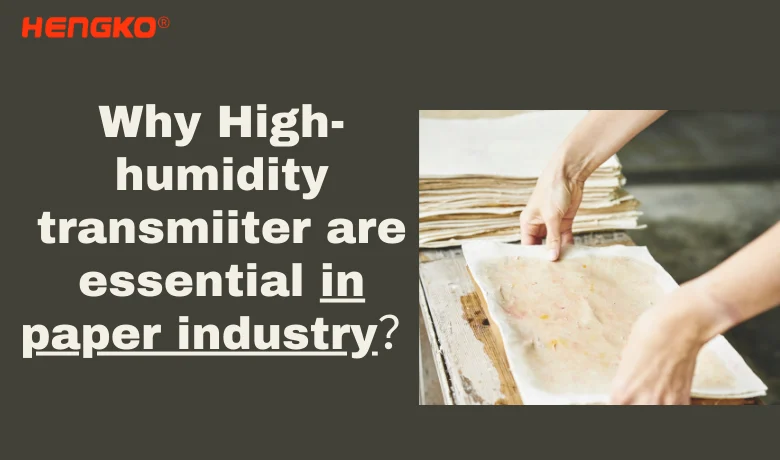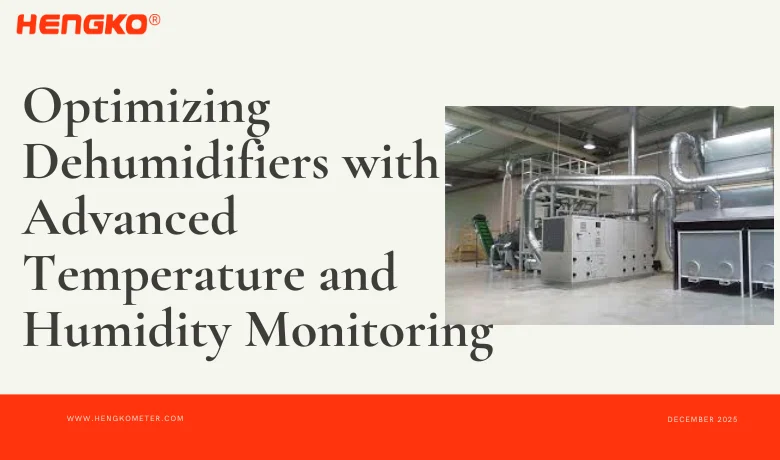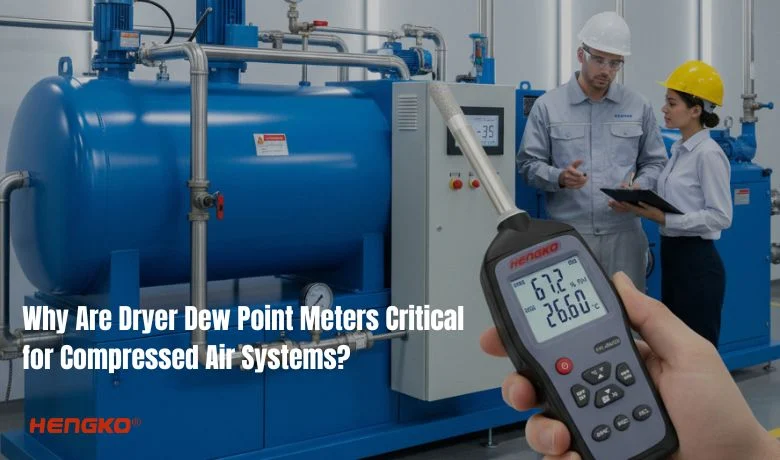In the demanding environment of the paper manufacturing industry, high humidity is not just common—it’s unavoidable. From the pulping stage to the drying process and even in storage areas, humidity levels often soar above 90%, accompanied by high temperatures and corrosive chemical vapors. For most electronic sensors, this is a recipe for rapid failure.
To maintain process stability and ensure paper quality, manufacturers must monitor temperature and humidity accurately. That’s where high humidity temperature and humidity transmitters become indispensable. These rugged sensors are specially designed to operate reliably in saturated air environments without drifting or degrading over time.
The Humidity Challenge in Paper Mills
Each stage of the papermaking process presents unique challenges:
1. Pulping Section – Harsh Beginnings
Ambiente: Steam-filled, chemical-laden air; high humidity >95%; corrosive gases (e.g., chlorine dioxide)
Applicazione:
In this area, pulp is created by chemically or mechanically breaking down wood fibers. Large digesters and tanks emit warm vapors and corrosive fumes.
How the transmitter is used:
High humidity transmitters are installed above pulping tanks and in ventilation ducts to monitor ambient RH and temperature. The data is used to regulate airflow and exhaust systems, helping to minimize condensation on walls and equipment, which could otherwise lead to mold, corrosion, and structural damage.
Why it matters:
Precise control of humidity reduces chemical vapor accumulation and improves worker safety, while protecting infrastructure and ensuring stable pulping reactions.
2. Press Section – Moisture Management
Ambiente: High temperature and moisture from dewatering process
Applicazione:
Here, large mechanical presses remove excess water from the paper sheet. Although the goal is dewatering, the ambient environment remains wet and humid.
How the transmitter is used:
Sensors are installed near press rolls and under the canopy hood to monitor RH and temperature, feeding real-time data to HVAC systems and heat recovery units.
Why it matters:
Maintaining stable conditions ensures that water removal is efficient without over-drying or uneven sheet moisture, directly affecting paper strength and uniformity.
3. Drying Section – Precision Under Pressure
Ambiente: Hot air, saturated steam, fast temperature changes
Applicazione:
Dryers evaporate remaining moisture from the pressed sheets. The drying stage is energy-intensive and sensitive to environmental changes.
How the transmitter is used:
Transmitters are embedded inside the dryer chamber walls or air ducts to monitor the temperature gradient and RH levels in real time. These values are used to control dryer temperature, exhaust fans, and steam valves.
Why it matters:
Better control of RH and temperature means more consistent drying, improved energy efficiency, and fewer defects like warping, curling, or breaks in the paper web.
4. Calendering and Finishing – The Quiet Critical Point
Ambiente: Conditioned but still humid due to residual moisture
Applicazione:
Before cutting and rolling, paper passes through calender rolls that give it smoothness and gloss. Even minor moisture fluctuations can affect results.
How the transmitter is used:
Installations near the finishing line ensure stable ambient RH, preventing unwanted paper deformation or static buildup during cutting.
Why it matters:
Stable humidity helps achieve the desired finish and improves machine handling, reducing waste and increasing throughput.
5. Paper Storage – Protecting the Final Product
Ambiente: Controlled ambient air, moderate RH (recommended: ~50-55%)
Applicazione:
After production, paper reels are stored before shipment. Paper is hygroscopic—it absorbs or releases moisture depending on the environment.
How the transmitter is used:
High-accuracy transmitters are placed strategically throughout the warehouse, integrated into the central HVAC control system to maintain optimal RH.
Why it matters:
Avoids product degradation such as curling, mold growth, and strength loss. Ensures paper quality during long-term storage and protects your bottom line.
Key Features of High Humidity Transmitters
To meet the specific demands of the paper industry, high humidity transmitters integrate several critical design advantages:
1.Anti-Condensation Design
In saturated environments, condensation is inevitable. Advanced models are equipped with hydrophobic filter membranes or internal heating elements that prevent water accumulation inside the sensor, ensuring continuous, reliable readings.
2.Corrosion-Resistant Construction
These transmitters often feature enclosures made from 316L stainless steel, anodized aluminum, or chemically resistant plastics to protect against aggressive vapors and long-term oxidation.
3. Long-Term Stability
Thanks to sealed sensing elements and rugged design, high humidity transmitters maintain their accuracy (±1.5% RH or better) even under continuous exposure to near-100% relative humidity.
4. Industrial Integration Support
Support for industrial protocols like Modbus RTU, 4–20mA analog output, or 0–10V voltage signals enables seamless integration into paper mill SCADA systems or local PLC controls.
Benefits for Paper Manufacturing
Using the right sensor technology in key production areas leads to substantial operational improvements:
- Improved Paper Quality
Stable humidity control during pressing and drying helps maintain consistent moisture levels in the paper sheet. This prevents defects such as curling, uneven thickness, or paper breakage during winding.
-Better Process Control
Reliable real-time data allows for faster adjustment of process variables like dryer temperature and airflow. This optimizes energy consumption and boosts throughput.
-Reduced Maintenance
Sensors designed for high humidity require less frequent replacement or recalibration, reducing downtime and maintenance labor costs.
-Energy & Cost Savings
Avoiding over-drying or process inefficiencies can significantly reduce energy bills and improve first-pass yield, saving both resources and money.
Application Zones & Recommended Specifications
| Production Zone | Condizioni ambientali | Sensor Requirements |
| Pulping Section | >95% RH, steam, corrosive gas | Sealed design, chemical resistance |
| Press Section | High temperature, water spray | Anti-condensation, rapid response |
| Drying Section | Heat cycles, saturated steam | Thermal stability, long-term durability |
| Storage Area | Stable, moderate RH (~50–60%) | High accuracy, low drift, long service life |
Conclusione
In the paper industry, controlling humidity isn’t just about equipment protection—it’s about product consistency, process optimization, and long-term operational savings. The use of high humidity temperature and humidity transmitters is a smart, necessary investment for any facility aiming to improve reliability and quality in high-moisture environments.
With advanced protection against condensation, corrosion, and signal drift, these sensors offer lasting performance in some of the harshest industrial conditions. Whether you’re upgrading existing monitoring systems or planning a new production line, don’t overlook the importance of humidity control. Your paper—and your bottom line—depends on it.
One Paper Plant, Multiple Challenges — One Reliable Solution
From pulp to storage, the HG808-H High Humidity Temperature & Humidity Transmitter is purpose-built to conquer extreme industrial moisture.
Whether it’s >90% RH, chemical gases, oil mist, or steam — HG808-H takes it all in stride.
With a dual-layer protection system featuring a die-cast aluminum housing and a stainless steel sensor module, it delivers long-term stability even in 80–95% RH conditions — lasting over three times longer than conventional sensors.
- In the pulping section, it resists corrosion and steam.
- In the pressing area, it delivers fast, fog-free readings with anti-condensation tech.
- In the drying zone, it endures heat cycles without losing calibration.
- In the storage space, it maintains ±2%RH accuracy with minimal drift.
Powered by composite sensing technology and enhanced by multi-layer interference protection, HG808-H ensures accurate readings even under the most chaotic industrial conditions.
At HENGKO, we specialize in high-humidity-resistant temperature and humidity transmitters engineered for the toughest industrial environments. Whether you need precise monitoring in the pulping zone or stable control in your storage facilities, our solutions are built to perform—accurately, reliably, and long-term.
Contattateci all'indirizzo sales@hengkometer.com to discuss how our transmitters can support your production goals, or request a free consultation with our technical team.






